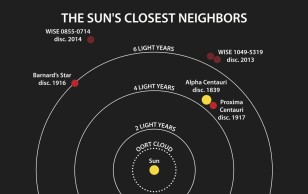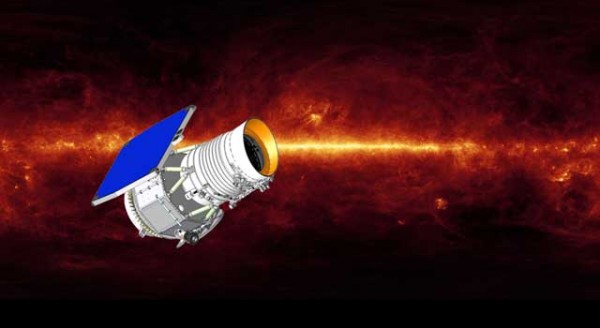
Artist’s conception of the brown dwarf WISE J085510.83-071442.5. The bright star directly to the right of the brown dwarf is the Sun. (Robert Hurt/JPL, Janella Williams/Penn State University)
The coldest-ever brown dwarf star has been found about 7 light-years away from Earth and could help scientist learn more about the atmospheres of planets.
Brown dwarfs are objects that are too big to be planets, but too small to be considered stars. They begin their lives like stars, but since their mass is so low, they are unable to produce the energy needed to be star.
A Penn State University astronomer used NASA’s Wide-field Infrared Survey Explorer (WISE) and Spitzer Space Telescopes to find the icy object dubbed WISE J085510.83-071442.5. Its temperature is between -48 to -13 degrees Celsius, even colder than the average winter temperature of the Arctic.
The WISE and Spitzer also found other brown dwarfs that were at one time the coldest such objects found. Their temperatures were measured to be around room temperature somewhere between 20 and 23.5 °C.

Locations of star systems that are closest to the Sun and the year they were discovered. (Janella Williams, Penn State University)
The newly discovered brown dwarf star is the fourth closest star system to the Sun.
“It is very exciting to discover a new neighbor of our solar system that is so close,” said Kevin Luhman, an associate professor of astronomy and astrophysics at Penn State. “In addition, its extreme temperature should tell us a lot about the atmospheres of planets, which often have similarly cold temperatures.”
The astronomers spotted the brown dwarf with the WISE space telescope after conducting a thorough infrared survey of the entire sky. The observers scanned the cosmos up to three times in some areas of the sky.
Infrared observations are one of the only way for astronomers to detect chilly objects like brown dwarf stars. Unlike visible light telescopes, infrared telescopes pick up on an object’s heat signature no matter how faint it might be. Objects such as the brown dwarf would be invisible to visible light telescopes.
The astronomers relied on data from Spitzer’s infrared observations to help them determine the icy brown dwarf’s temperature, and a combination of detections from Spitzer and WISE helped them to assess the object’s distance.
“It is remarkable that even after many decades of studying the sky, we still do not have a complete inventory of the Sun’s nearest neighbors,” said Michael Werner, project scientist for Spitzer at NASA’s Jet Propulsion Laboratory (JPL) in Pasadena, California. “This exciting new result demonstrates the power of exploring the universe using new tools, such as the infrared eyes of WISE and Spitzer.”

Artist’s concept of the Wide-field Infrared Survey Explorer. (NASA)
It’s estimated that the WISE J085510.83-071442.5 dwarf star is between three-to-10 times the mass of Jupiter.
The astronomers say that, with such a low mass, the brown dwarf could very well have been a gas giant planet, such as our solar system’s outer four planets Jupiter, Saturn, Uranus and Neptune, that had been kicked out of its star system.
Since these types of objects are fairly common in the cosmos, the astronomers have determined that it’s not a planet but a brown dwarf, albeit one of the least massive brown dwarfs that have been found.






















Comments are closed.